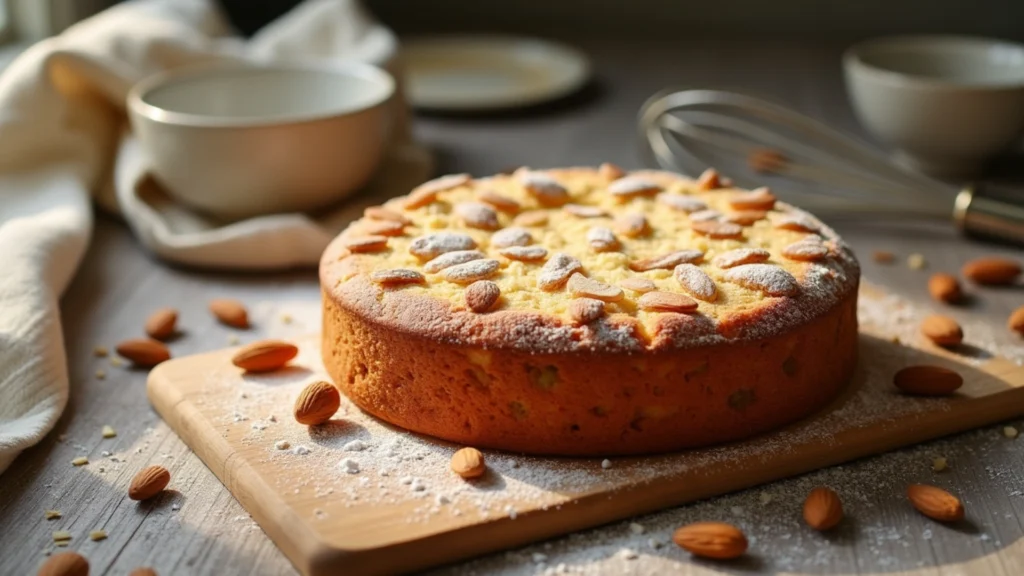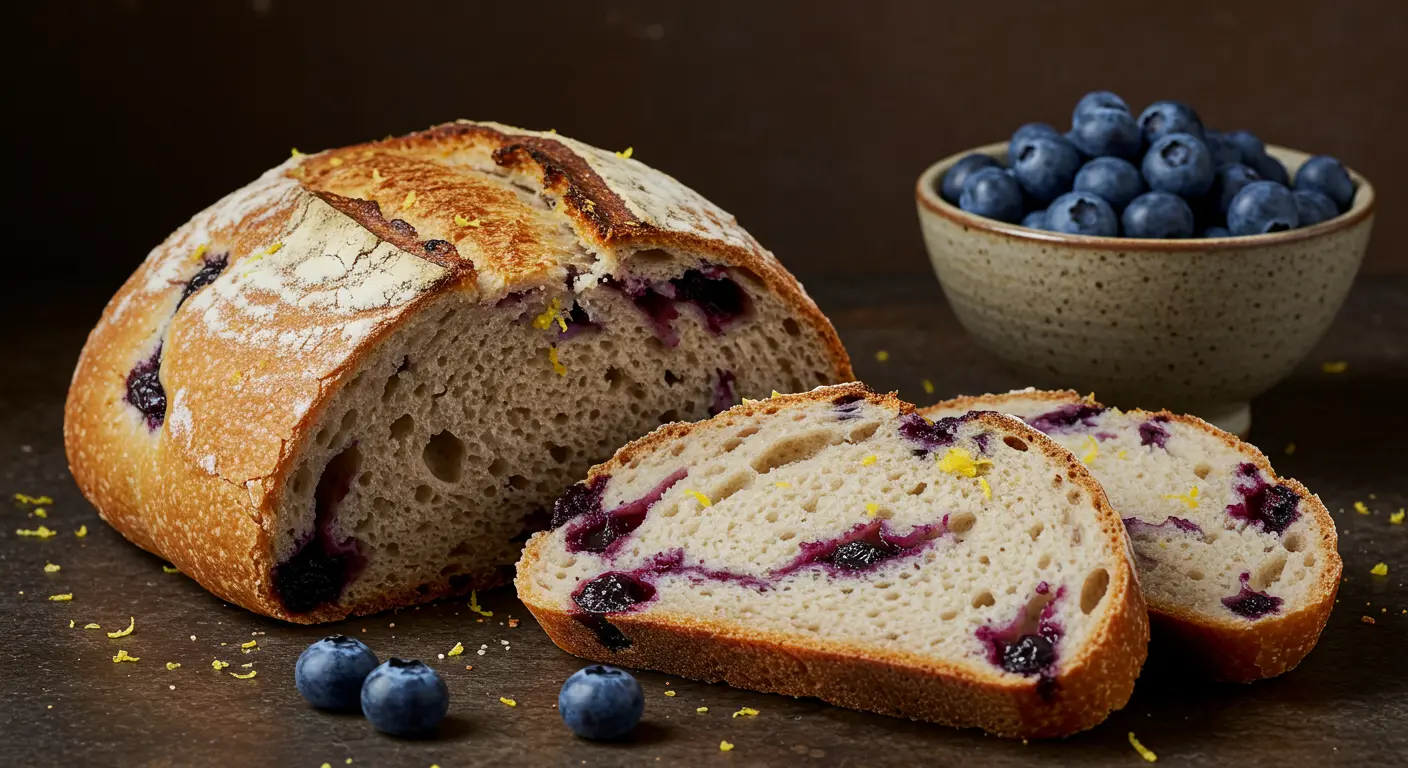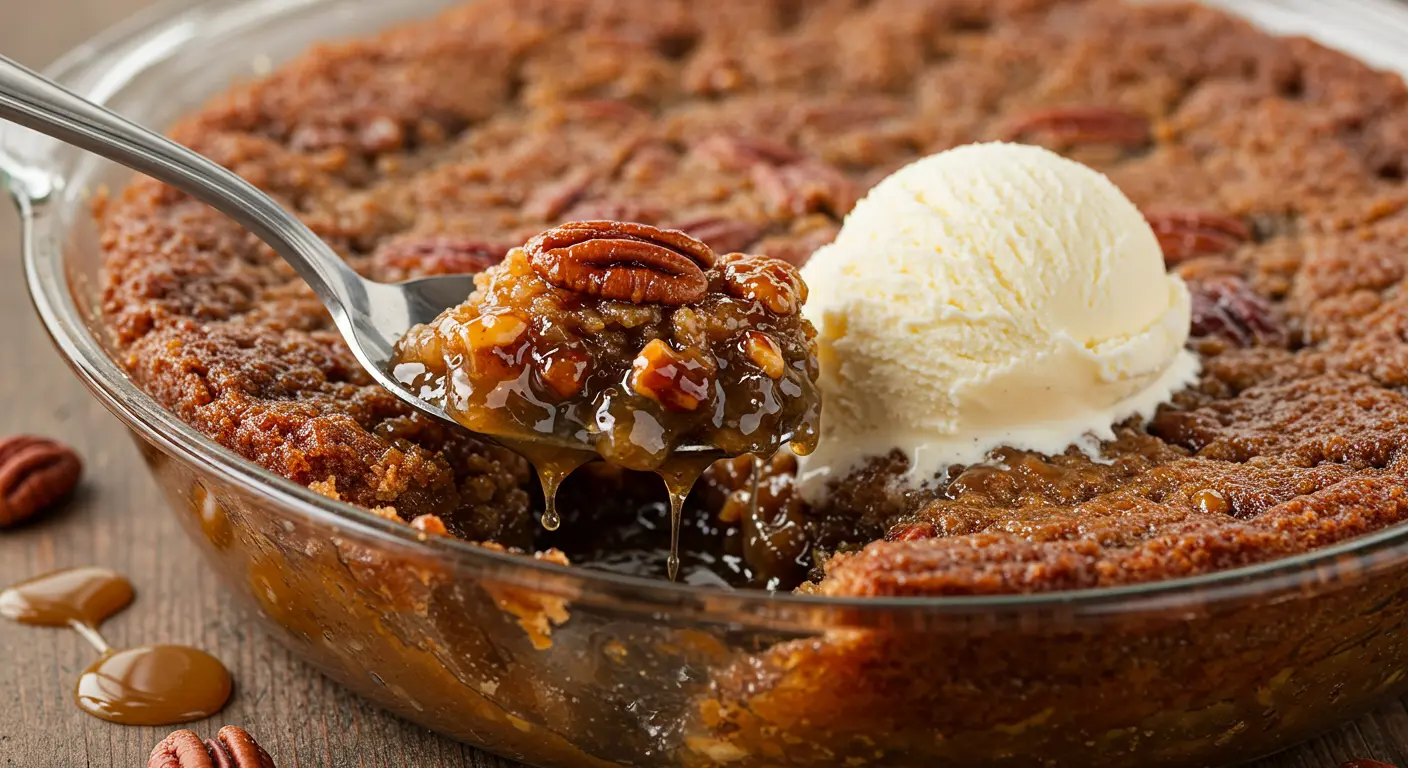Almond nut cake recipe—a delicately sweet, nutty dessert with a moist, tender crumb—is the epitome of simple elegance. Imagine the aroma of roasted almonds wafting through your kitchen, the golden crust crackling softly under your knife, and the first bite melting in your mouth with its buttery richness.
Whether you’re looking to create a show-stopping centerpiece for a celebration or simply indulging in a weekend baking project, this almond nut cake recipe is your go-to. Loved for its versatility and ease, it fits effortlessly into any occasion while delivering a flavor that’s anything but ordinary.
Why does this Almond cake recipe work so well? The combination of finely ground almonds, rich butter, and light, fluffy eggs creates a perfectly balanced cake. It’s moist without being dense, sweet but not overpowering, and incredibly aromatic thanks to the toasted almonds. Plus, the use of almond flour makes this cake a great choice for a gluten free almond cake.
So, let’s dive in and explore what makes this almond nut cake recipe your new favorite dessert.
Quick Recipe Card
Prep Time: 15 minutes
Cook Time: 30 minutes
Total Time: 45 minutes
Difficulty: Easy
Servings: 8
Equipment Needed
Mixing bowls
Electric mixer or whisk
9-inch (23 cm) round cake pan
Parchment paper
Ingredients
1 ½ cups (150g) almond flour
½ cup (100g) granulated sugar
3 large eggs
¼ cup (60g) unsalted butter, melted
1 tsp (5g) vanilla extract
½ tsp (2g) baking powder
¼ tsp (1g) salt
Optional: ¼ cup (25g) slivered almonds for topping
Instructions
Preheat your oven to 350°F (175°C). Lightly grease a 9-inch cake pan and line it with parchment paper.
Combine the eggs and sugar in a bowl, whisking until the mixture is pale and airy. Add melted butter and vanilla extract.
Gently fold in almond flour, baking powder, and salt until combined.
Pour the batter into the prepared pan, smooth the top, and sprinkle with slivered almonds.
Bake for approximately 30 minutes, or until the top turns golden and a toothpick inserted into the center comes out clean.
Cool before slicing and serving.
INGREDIENT DEEP DIVE

Each ingredient in this almond nut cake recipe plays a vital role in creating its perfect flavor and texture, and If you’re looking for a gluten-free almond cake, almond flour is an excellent substitute for wheat flour. Let’s break down the key components, explore substitutions, and learn how to make the most of each one.
Key Ingredients
Almond Flour
Purpose: Almond flour is the star of this recipe, providing a naturally nutty flavor and moist texture. Its gluten-free nature also makes the cake a great option for those avoiding wheat.
Tips: Use finely ground almond flour for a smooth, even crumb. Avoid almond meal, which is coarser and can make the cake dense.
Substitutions: For a slightly different texture, you can use hazelnut flour, but it will alter the flavor.
Granulated Sugar
Purpose: Sugar sweetens the cake and helps create a light, tender crumb.
Tips: If you prefer a milder sweetness, reduce the sugar slightly.
Substitutions: Replace granulated sugar with coconut sugar for a caramel-like depth or with a sugar substitute for a lower-calorie option.
Eggs
Purpose: Eggs bind the ingredients together and provide structure while contributing to the cake’s airy texture.
Tips: Bring the eggs to room temperature before mixing for better incorporation and volume.
Substitutions: For a vegan alternative, use flax eggs (1 tbsp flaxseed meal + 2.5 tbsp water per egg) or an egg replacer.
Unsalted Butter
Purpose: Butter adds richness and enhances the almond flavor.
Tips: Melt the butter and allow it to cool slightly before adding it to the batter.
Substitutions: For a dairy-free version, use coconut oil or a plant-based butter alternative.
Vanilla Extract
Purpose: Vanilla enhances the sweetness and rounds out the almond flavor.
Tips: Use pure vanilla extract for the best taste.
Substitutions: Almond extract can be used for a more intense almond flavor, but reduce the amount to ½ tsp as it is more potent.
Baking Powder
Purpose: This leavening agent allows the cake to rise, giving it a soft and airy texture.
Tips: Check the expiration date on your baking powder to ensure it’s fresh, as expired powder will not work effectively.
Substitutions: Use ½ tsp of baking soda combined with 1 tsp of lemon juice or vinegar if you don’t have baking powder.
Salt
Purpose: A pinch of salt balances the sweetness and enhances all the flavors in the cake.
Tips: Use fine sea salt for even distribution. Avoid omitting this ingredient, as it’s crucial for flavor balance.
Slivered Almonds (Optional)
Purpose: These add a delightful crunch and enhance the presentation.
Tips: Toast the almonds lightly before sprinkling them on the batter for a deeper, nutty flavor.
Storage Tips for Ingredients
Almond Flour: Store in an airtight container in the refrigerator or freezer to keep it fresh and prevent rancidity.
Butter: Keep it in the fridge and bring it to room temperature before use.
Eggs: Store eggs in their carton in the fridge and let them sit at room temperature for about 30 minutes before using.
Temperature Requirements
For even mixing, ensure all ingredients are at room temperature. This helps the batter combine smoothly and bake evenly.
These ingredients come together to create the magic of this almond nut cake recipe, and with a few tweaks, you can customize it to suit your taste or dietary preferences.
EQUIPMENT NEEDED
Ensuring you have the right equipment is key to perfecting your almond nut cake recipe every time. Here’s a breakdown of what you’ll need and alternative options for each item.
Essential Tools
Mixing Bowls
Purpose: For combining wet and dry ingredients separately before mixing them together.
Tips: Use one large and one medium-sized bowl to make the process smooth.
Electric Mixer or Whisk
Purpose: Helps to whip the eggs and sugar for a light, fluffy batter.
Tips: If using a whisk, make sure to whisk vigorously to incorporate enough air into the mixture.
Alternative: A stand mixer with a whisk attachment is perfect for hands-free mixing.
9-Inch (23 cm) Round Cake Pan
Purpose: This is the standard size for this almond cake recipe, ensuring even baking.
Tips: Grease the pan well and line it with parchment paper to prevent sticking.
Alternative: If you don’t have a round pan, an 8-inch square pan can work, though the baking time may vary slightly.
Measuring Cups and Spoons
Purpose: For accurate measurement of ingredients to maintain the recipe’s balance.
Tips: Use separate measuring cups for dry and liquid ingredients for best results.
Spatula
Purpose: Useful for folding in the almond flour without deflating the batter.
Alternative: A wooden spoon can also work in a pinch.
Parchment Paper
Purpose: Prevents the cake from sticking to the pan and makes cleanup easier.
Tips: Cut the paper to fit the base of your pan perfectly for a smooth finish.
Alternative Options
Hand Mixer: If you don’t have an electric mixer, a hand mixer can do the job, though it may take slightly longer.
Springform Pan: Ideal for easy release, especially if serving the cake directly from the pan.
With these tools, you’ll be fully equipped to make this almond nut cake recipe with ease and confidence.
STEP-BY-STEP INSTRUCTIONS

Making this almond nut cake recipe is a straightforward process, but attention to detail ensures your almond flour cake comes out light, fluffy, and perfectly moist. Follow these step-by-step instructions to create a dessert that’s as beautiful as it is delicious.
1. Preheat the Oven
Set your oven to 350°F (175°C) and allow it to preheat fully.
Grease a 9-inch (23 cm) round cake pan and line the bottom with parchment paper.
Pro Tip: Preheating the oven ensures even baking and prevents the batter from sitting too long, which can affect the cake’s texture.
2. Prepare the Wet Ingredients
In a large mixing bowl, crack 3 large eggs and add ½ cup (100g) granulated sugar.
Beat the mixture with an electric mixer or whisk for 2–3 minutes, until it becomes pale and fluffy.
Slowly drizzle in ¼ cup (60g) melted unsalted butter while continuing to mix.
Add 1 tsp (5g) vanilla extract and mix until fully incorporated.
Visual Cue: The batter should expand in volume and develop a light, airy consistency.
3. Combine the Dry Ingredients
In a separate bowl, sift together:
1 ½ cups (150g) almond flour
½ tsp (2g) baking powder
¼ tsp (1g) salt
Gradually incorporate the dry ingredients into the wet mixture by folding with a spatula.
Technique Tip: Fold gently to preserve the airiness of the batter. Overmixing can result in a dense cake.
4. Assemble the Cake
Pour the batter into the prepared cake pan, spreading it evenly.
If desired, sprinkle ¼ cup (25g) slivered almonds on top for added texture and visual appeal.
Timing Tip: Work quickly to ensure the batter doesn’t lose its volume.
5. Bake the Cake
Place the pan on the middle rack of the oven and bake for 30-35 minutes.
Check if the cake is ready by inserting a toothpick in the center; it should come out clean or with a few moist crumbs.
Common Pitfall: If the top starts to brown too quickly, tent it with foil during the last 10 minutes of baking.
6. Cool and Unmold
Once baked, let the cake cool in the pan for 10 minutes before transferring it to a rack.
Run a knife around the edges to loosen the cake, then invert it onto a wire rack to cool completely.
Timing Tip: Allow the cake to cool fully before slicing to avoid crumbling.
7. Serve and Enjoy
Slice the cake into wedges and serve as is, or dust with powdered sugar for a touch of elegance.
Pair with coffee, tea, or a scoop of vanilla ice cream for an indulgent treat.
Troubleshooting Common Issues
Dense Cake: Likely due to overmixing or using coarse almond meal instead of almond flour.
Sinking Middle: Ensure the oven is preheated, and avoid opening the door during baking.
Dry Texture: Check your oven temperature with an oven thermometer; it might be running too hot.
By following these detailed instructions, you’re guaranteed to achieve a flawless almond flour cake every time.
EXPERT TIPS AND TRICKS

To make your almond nut cake recipe truly exceptional, consider these expert insights. Whether you’re a seasoned baker or a beginner, these tips will help you avoid common mistakes and elevate your baking experience.
1. Perfecting the Texture
Eggs Are Key: Whipping the eggs and sugar until light and fluffy creates a stable base for the batter, ensuring the cake has an airy texture.
Fold, Don’t Stir: Gently fold in the almond flour to maintain the batter’s volume. Overmixing will cause the air to escape, leading to a denser texture.
2. Enhancing Flavor
Toast the Almond Flour: Lightly toasting the almond flour before use can bring out its nutty aroma, adding depth to the cake’s flavor.
Add Zest: A teaspoon of lemon or orange zest can complement the almond flavor beautifully.
3. Avoiding Pitfalls
Check Your Almond Flour: Always use fresh almond flour, as it can go rancid if stored improperly.
Even Baking: Rotate the cake halfway through baking to ensure it browns evenly, especially if your oven has hot spots.
4. Make-Ahead Instructions
Prepare in Advance: This cake stores well, making it a great make-ahead dessert. Bake the cake up to two days ahead and store it tightly wrapped at room temperature.
Freeze for Later: Wrap individual slices in plastic wrap and place them in a freezer-safe bag. Thaw at room temperature when you’re ready to serve.
5. Storage Guidelines
Room Temperature: Store the cake in an airtight container for up to three days to keep it moist and fresh.
Refrigeration: For optimal storage, keep the cake refrigerated for up to seven days and allow it to reach room temperature before serving for the best flavor and texture.
6. Baking for Special Diets
Gluten-Free Perfection: This recipe is naturally gluten-free, but always double-check that your almond flour and baking powder are certified gluten-free if you’re baking for someone with gluten intolerance.
Dairy-Free Option: Substitute the butter with coconut oil or a plant-based alternative to make the cake dairy-free without compromising on flavor.
7. Presentation Matters
Finish with Flair: A light dusting of powdered sugar or a drizzle of honey can elevate the cake’s appearance.
Plating Tips: Serve slices with fresh berries or a dollop of whipped cream for an elegant touch.
By applying these tips, you’ll master this almond nut cake recipe, ensuring every bite is as delicious as the last.
VARIATIONS AND CUSTOMIZATIONS

One of the best parts of this almond nut cake recipe is its versatility. You can adapt it to suit various tastes, dietary needs, and occasions. Below are creative ways to customize this recipe while keeping its signature nutty flavor intact.
1. Seasonal Adaptations
Spring: Add a handful of fresh raspberries or blueberries to the batter for bursts of fruity flavor.
Summer: Top the cake with a layer of lightly sweetened whipped cream and sliced peaches for a fresh, seasonal dessert.
Autumn: Incorporate warm spices like cinnamon, nutmeg, or cardamom into the batter to create a cozy fall treat.
Winter: Drizzle the cake with a citrus glaze made from orange juice and powdered sugar for a festive touch.
2. Dietary Modifications
Gluten-Free: This recipe is naturally gluten-free thanks to almond flour, but ensure all ingredients (like baking powder) are certified gluten-free for safety, this way you will have a gluten free almond cake
Vegan: Replace the eggs with flax eggs (1 tablespoon ground flaxseed + 2.5 tablespoons water per egg). Substitute dairy butter with plant-based butter or coconut oil for a dairy-free option.
Keto-Friendly: Substitute granulated sugar with a keto-approved sweetener like erythritol or monk fruit sweetener.
3. Flavor Variations
Chocolate Almond Cake: Mix 2 tablespoons of unsweetened cocoa powder into the almond flour for a rich, chocolatey twist.
Coconut Almond Cake: Replace ¼ cup (25g) of almond flour with unsweetened shredded coconut for a tropical flair.
Almond Lemon Cake: Add 1 tablespoon of lemon juice and 1 teaspoon of lemon zest to brighten the flavor.
4. Decoration Ideas
Classic Finish: Dust the cooled cake with powdered sugar for an elegant and simple look.
Nutty Topper: Sprinkle toasted almond slivers or chopped pistachios over the batter before baking for extra crunch.
Frosted Elegance: Coat the cake with a layer of cream cheese frosting flavored with vanilla or almond extract.
5. Special Occasion Customizations
Birthday Cake: Layer the cake with almond-flavored buttercream and fresh berries for a celebratory dessert.
Holiday Treat: Decorate with edible gold leaf or silver dragées to make the cake sparkle for festive occasions.
By experimenting with these variations, you can tailor this almond nut cake recipe to fit any occasion or preference, making it a truly versatile dessert.
SERVING AND PRESENTATION

Presentation can transform this almond nut cake recipe from a simple dessert into a show-stopping centerpiece. Follow these tips for serving, plating, and pairing to make every slice look as good as it tastes.
1. Plating Suggestions
Classic Elegance: Slice the cake into neat wedges and serve on white plates to emphasize its golden hue.
Rustic Charm: Place the cake on a wooden serving board, garnish with fresh herbs like mint, and dust with powdered sugar for a homestyle vibe.
Mini Portions: Use a round cookie cutter to create individual servings for an elegant afternoon tea presentation.
2. Accompaniment Recommendations
Whipped Cream: Add a dollop of lightly sweetened whipped cream to each slice for extra indulgence.
Fresh Fruits: Pair with seasonal fruits like strawberries, blueberries, or orange slices for a pop of color and complementary flavor.
Ice Cream: Serve warm slices with a scoop of vanilla or almond-flavored ice cream for a decadent treat.
Drinks:
Tea: A lightly brewed Earl Grey or chamomile tea complements the nutty flavor.
Coffee: Espresso or a latte pairs perfectly with the cake’s richness.
Wine: Try a dessert wine like Moscato or a dry Prosecco for special occasions.
3. Pairing Suggestions
Morning Treat: Serve plain slices with a steaming cup of coffee for a delightful breakfast or brunch addition.
Dinner Party Finale: Pair the almond flour cake with dessert wines like Sauternes or an almond liqueur for a refined ending to a meal.
With thoughtful plating and pairing, this almond nut cake recipe becomes more than just a dessert—it’s a memorable experience.
CONCLUSION
This almond nut cake recipe is more than just a dessert—it’s a celebration of rich, nutty flavors and a versatile treat that fits any occasion. Whether you’re baking it for a family gathering, a festive celebration, or simply to enjoy with your morning coffee, this cake is guaranteed to impress with its moist texture, delicate sweetness, and timeless appeal.
Try it today! We’d love to see how your almond flour cake turns out—don’t forget to tag us on social media with your beautifully plated almond cake!
FAQ SECTION
1. Can I substitute almond meal for almond flour?
Yes, but keep in mind that almond meal has a coarser texture and may make the cake slightly denser. For optimal results, finely ground almond flour is recommended
2. How do I store this almond nut cake?
Store the cake in a sealed, airtight container at room temperature for up to three days. For longer preservation, refrigerate it for up to a week or freeze slices individually for up to three months.
3. Is this recipe suitable for gluten-free diets?
Absolutely! This recipe is naturally gluten-free, using almond flour instead of wheat flour. Ensure all ingredients are certified gluten-free if necessary.
4. Can I make this cake dairy-free?
Yes, you can substitute the butter with coconut oil or a plant-based butter alternative. The flavor may vary slightly but will still be delightful.
5. What’s the best way to ensure my cake is moist?
Don’t overbake: Check for doneness with a toothpick around the 30-minute mark.
Measure ingredients accurately: Too much almond flour can make the cake dry.
Store properly: Wrap tightly to lock in moisture when storing leftovers.
6. Can I make this cake in advance?
Yes, this cake can be made 1-2 days in advance. Wrap it tightly in plastic wrap and store at room temperature. Add any garnishes or toppings just before serving.
7. What can I pair with this cake for a special occasion?
For a refined pairing, serve the cake with a dessert wine like Moscato or Prosecco, or add a side of whipped cream and fresh berries.
Now it’s your turn! Bake this easy yet sophisticated almond nut cake recipe and let us know how it turned out. Have more questions? Leave them in the comments, and we’ll be happy to help!






